
Doris first saw Granada in 2006 on a trip to Spain, where Greg and Carole were teaching. It was February and cold. Madrid is a big city and crowded. Greg and Carole worked five days a week. Rental cars were cheap. The sun and romance of Andalusia were a few clicks of the odometer away. Fabled Granada became the first stop on a run to the sun.
There is nothing in Europe quite like Granada’s Alhambra. Topkaki Palace in Istanbul comes closest, but it wasn’t even under construction by the time the Alhambra’s sultans were kicked out of their Granada digs. Globetrotting Louis was overdue for a visit. After 10 days with los Sevillanos, we set off by train and bus for the last redoubt of the Muslim empire in Iberia, the foothill city where the plain meets the Sierra Nevada.
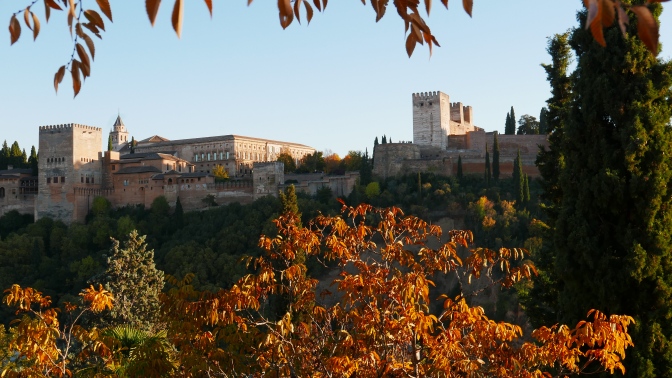
Muslims (more often “Moors” in Iberian history) ruled parts of Spain and Portugal from the early 700s until 1492 – longer than the Christians who succeeded them. Their capital, Córdoba, became the largest and most modern city in all of Europe. Half a millennium later, architecture and art created under their long reign continue to give the region a distinctly Arabic flavor, nowhere stronger than in Granada.
It was in Granada in 1492 that Isabel I of Aragon and Fernando II of Castile completed their “reconquest” of what would become Spain and where the last sultan surrendered to them. Also here, the royal couple commissioned Christopher Columbus to sail west to India, expelled the peninsula’s Jews, burned 80,000 books written in Arabic, initiated the Spanish Inquisition, ruled, died and are entombed in simple lead caskets beneath the royal chapel.
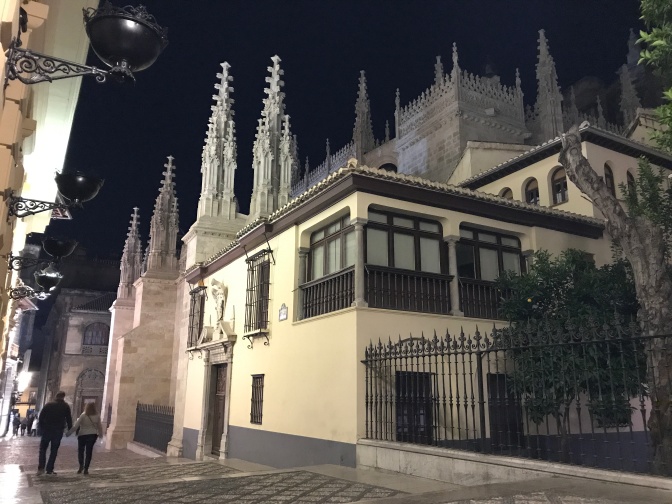
Of course, Isabel and Fernando wasted no time claiming the Alhambra for their own, and no wonder. The theme of the palace was “paradise on earth.” Column arcades and keyhole doorways connect courtyards and lead to soothing fountains and still reflecting pools. Sunlight dances everywhere. Huge and grand as it is, its rooms manage to remain intimate, inviting and cool.

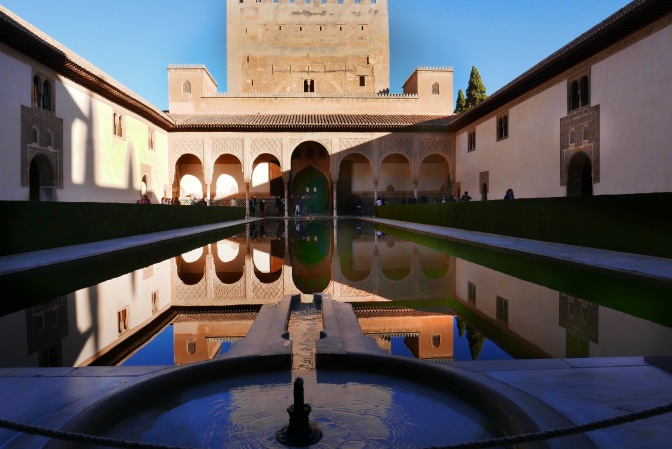
 The royals also wasted no time in remodeling to their taste. They broke through walls to connect interior palaces and removed privacy lattices to improve the views. Their grandson Charles V continued the embellishments by erecting an immense renaissance palace inside the compound commensurate with his status as Holy Roman Emperor. All this was nothing compared to the modifications of Napoleon, whose armies flattened palaces and buried courtyards with the rubble in retaliation for local resistance, ripping out the cedar of intricately carved ceilings for firewood.
The royals also wasted no time in remodeling to their taste. They broke through walls to connect interior palaces and removed privacy lattices to improve the views. Their grandson Charles V continued the embellishments by erecting an immense renaissance palace inside the compound commensurate with his status as Holy Roman Emperor. All this was nothing compared to the modifications of Napoleon, whose armies flattened palaces and buried courtyards with the rubble in retaliation for local resistance, ripping out the cedar of intricately carved ceilings for firewood.
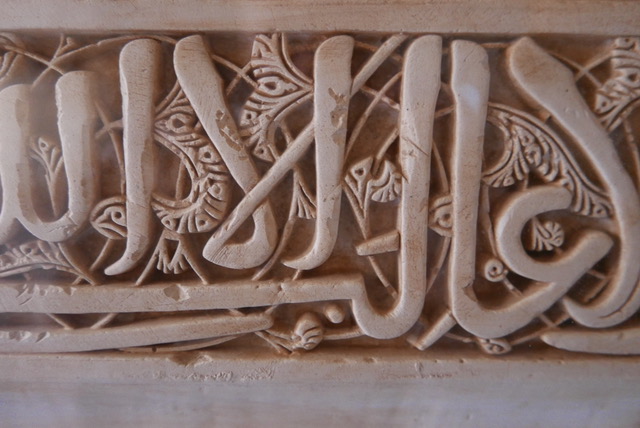
Time also exacted its toll. The whitewash on the Alhambra’s outside walls washed away, uncovering the earthen red of the palaces building materials. Inside, the vivid geometric shapes remain preserved in the tiles and stained glass, but vibrant reds, blues and golden yellows that once covered the walls and friezes faded.

By the time Washington Irving (founder of Sleepy Hollow, sire to Rip Van Winkle) became a literary squatter within the palace walls and published his best-selling Tales of the Alhambra in 1829, Granada had been on the map more than two thousand years and the Alhambra a fortress in some form for a thousand, but its continued survival was not assured. Our Spanish tour guide said the monument’s condition and worldwide fame today owe much to Irving’s book, which introduced the palace to the West and led to the tourist boom still echoing today. By the end of the 19th century, Spain had declared the site a national monument.
Granada is actually much more than the Alhambra – home to 50,000 Roma (as gypsies are more often called today), who planted the roots of flamenco in the caves of Sacramonte, where many still live across a ravine from the palaces, and to the Arabic labyrinth of streets called Albayzín, where defeated Muslims retreated after 1492 and stayed until they were expelled or otherwise eliminated once and for all.
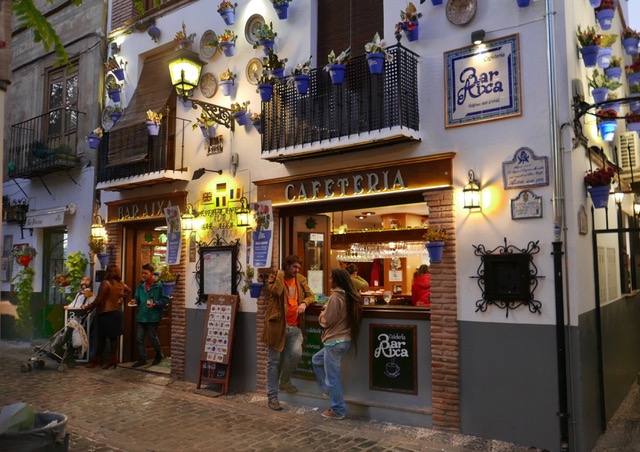
Granada in the rear-view mirror:
- Sunset at Mirador San Nicolas – Merrymakers converge nightly at this viewpoint to watch the sunset west of the Alhambra and see the monument illuminated after night falls.

- Tea rooms in Albayzín – Typical of enduring Muslim influence in Andalusia is this narrow street lined with teterias (tea rooms), hookah bars and pastry shops specializing in Syrian and other middle Eastern sweets.

- Hustlers on the plaza – North Africans continue to migrate to southern Spain. These get by, Times Square-style, by selling knockoffs to tourists from blankets and tarps they swiftly close around their wares when police come into view.

- Free tapas! – Granada is one of the last cities in Spain where tapas are still free and come with every drink you order. Yum.

- A photographer at his trade – If the ground is the only place to set up a tripod for a night shot of the royal chapel, you do what you have to do.

Despite appearances, this is not one of Granada’s abundant homeless (crummy photo from old iPhone)
HAPPY THANKSGIVING DAY!
Coming soon: Havana in Spain

We’re with Queen Isabel. Who wouldn’t want to live here?
Wonderful travelogue, Doris, next best thing to being there! I’ve added Alhambra to my travel bucket list. Oh, and I’d hang on to that photographer……😍.
LikeLike
Happy Thanksgiving from Lake Street next to a much-improved neighbor house! It’s raining, hard, so I know you aren’t homesick for Sandpoint. Down to the dirt on Schweitzer’s runs that were so white last weekend. Happy trails, Karen
LikeLike
Louis says you really know how to make us appreciate where we are!
LikeLike
Happy Thanksgiving!! I feel like I’ve just had a tour of Granada! Thank you both!
LikeLiked by 1 person
Lovely description and travel log! I visited the Alhambra in 1986 on my first and only trip to Spain. Amazing place.
LikeLiked by 1 person
It’s Thanksgiving morning and you have made my day with your photos and stories. My nomadic heart loves traveling along with you ❤️❤️❤️ Happy Thanksgiving!
LikeLiked by 1 person